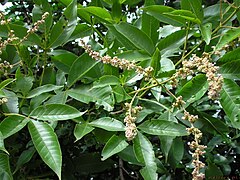Vitex
| Vitex | |
|---|---|
 |
|
| Vitex altissima | |
| Scientific classification | |
| Kingdom: | Plantae |
| (unranked): | Angiosperms |
| (unranked): | Eudicots |
| (unranked): | Asterids |
| Order: | Lamiales |
| Family: | Lamiaceae |
| Subfamily: | Viticoideae Briquet |
| Genus: |
Vitex L. |
| Type species | |
|
Vitex agnus-castus L. |
|
| Diversity | |
| About 250 species | |
| Synonyms | |
|
|
Vitex /ˈvaɪtɛks/ is a genus of flowering plants in the family Lamiaceae. It has about 250 species. Common names include "chastetree", traditionally referring to V. agnus-castus but often applied to other species as well.
Species of Vitex are native throughout the tropics and subtropics, with a few species in temperate Eurasia.
About 18 species are known in cultivation. Vitex agnus-castus and Vitex negundo are often grown in temperate climates. About six others are frequently grown in the tropics. Most of the cultivated species serve as ornamentals. Some provide valuable lumber. The flexible limbs of some species are used in basket weaving. Some of the aromatic species are used medicinally or to repel mosquitos.
The genus Vitex was named by Linnaeus in Species Plantarum in 1753.Vitex was the name used by Pliny the Elder for Vitex agnus-castus. It is derived from the Latin vieo, meaning to weave or to tie up, a reference to the use of Vitex agnus-castus in basketry.
...
Wikipedia
